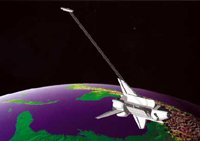Projects
SRTM

The Shuttle Radar Topography Mission was flown on the Space Shuttle Endeavour in February 2000, and it produced the first-ever near-global high-resolution digital elevation model (DEM) of Earth’s land surface. SRTM was an international project led by the National Geospatial-Intelligence Agency (NGA) and the National Aeronautics and Space Administration (NASA).
In 2013 JPL completed “SRTM Plus” (SRTM NASA Version 3), for distribution via the NASA LPDAAC (Land Processes Distributed Active Archive Center). SRTM Plus consists of SRTM Version 2 (primarily a water-masked “finishing” of the “unfinished” Version 1), plus void filling and other adjustments that mostly used GDEM2 (Global DEM Version 2) derived from stereoscopic images acquired by ASTER (Advanced Spaceborne Thermal Emission and Reflection Radiometer), a sensor on NASA’s Terra satellite. The voids in the SRTM DEM occur where topography confounded the radar imaging geometry (e.g., deep canyons) or was mirror-like and reflected-away the radar signal (e.g. smooth desert sand sheets).
Currently, the NASADEM Project funded under NASA’s MEaSUREs Program (Making Earth Science Data Records for Use in Research Environments) is reprocessing the original SRTM radar data, using decade-advanced software and new ancillary data sets (such as from ICEsat: NASA’s Ice, Cloud, and land Elevation Satellite). The result will be an improved SRTM DEM with fewer voids and better vertical accuracies. Voids still remaining will be filled with the then-latest version of GDEM and DEMs from several other sources. Completion of this processing is expected in early 2017.